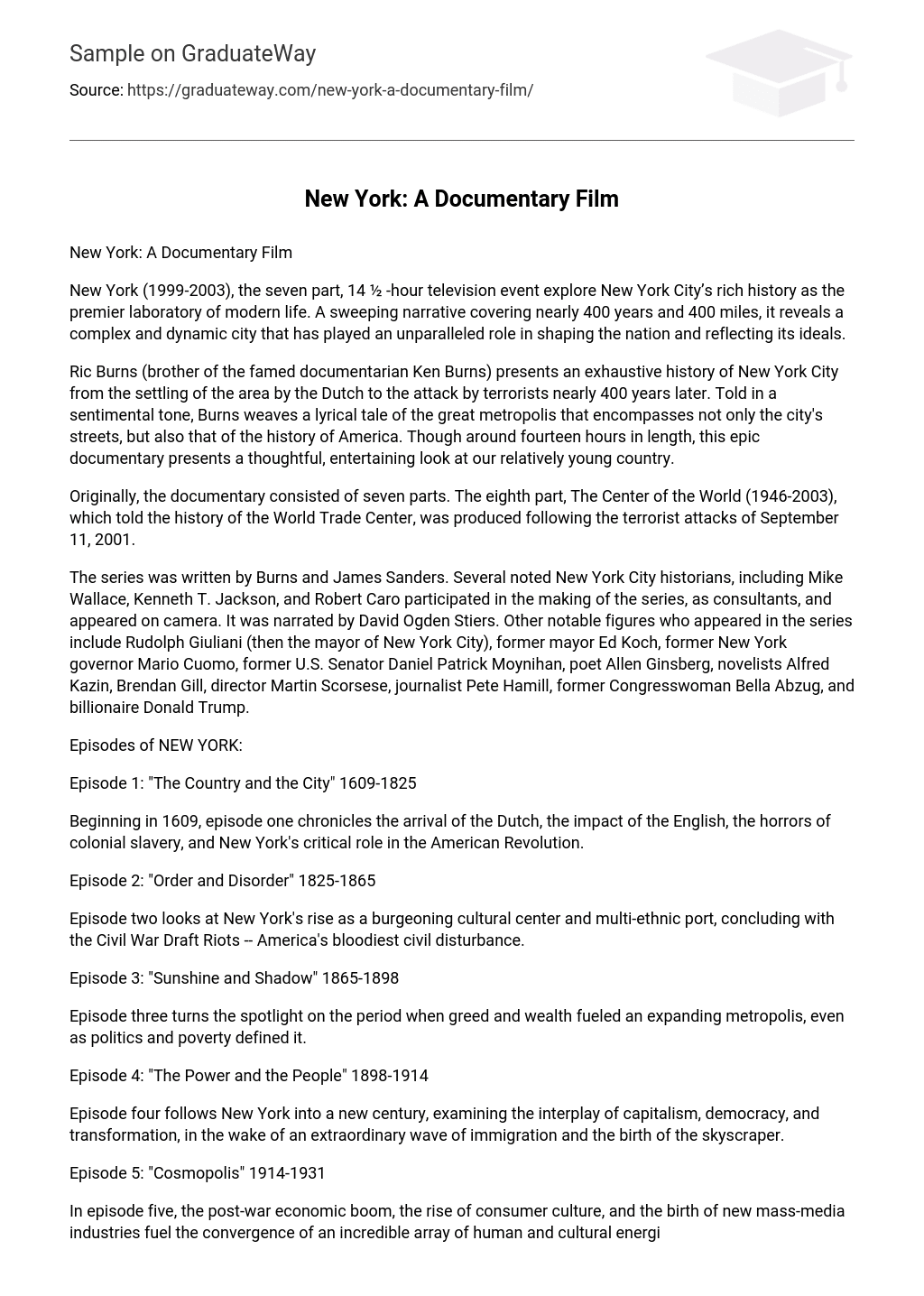New York (1999-2003), the seven part, 14 ½ -hour television event explore New York City’s rich history as the premier laboratory of modern life. A sweeping narrative covering nearly 400 years and 400 miles, it reveals a complex and dynamic city that has played an unparalleled role in shaping the nation and reflecting its ideals.
Ric Burns (brother of the famed documentarian Ken Burns) presents an exhaustive history of New York City from the settling of the area by the Dutch to the attack by terrorists nearly 400 years later. Told in a sentimental tone, Burns weaves a lyrical tale of the great metropolis that encompasses not only the city’s streets, but also that of the history of America. Though around fourteen hours in length, this epic documentary presents a thoughtful, entertaining look at our relatively young country.
Originally, the documentary consisted of seven parts. The eighth part, The Center of the World (1946-2003), which told the history of the World Trade Center, was produced following the terrorist attacks of September 11, 2001.
The series was written by Burns and James Sanders. Several noted New York City historians, including Mike Wallace, Kenneth T. Jackson, and Robert Caro participated in the making of the series, as consultants, and appeared on camera. It was narrated by David Ogden Stiers. Other notable figures who appeared in the series include Rudolph Giuliani (then the mayor of New York City), former mayor Ed Koch, former New York governor Mario Cuomo, former U.S. Senator Daniel Patrick Moynihan, poet Allen Ginsberg, novelists Alfred Kazin, Brendan Gill, director Martin Scorsese, journalist Pete Hamill, former Congresswoman Bella Abzug, and billionaire Donald Trump.
Episodes of NEW YORK:
Episode 1: “The Country and the City” 1609-1825
Beginning in 1609, episode one chronicles the arrival of the Dutch, the impact of the English, the horrors of colonial slavery, and New York’s critical role in the American Revolution.
Episode 2: “Order and Disorder” 1825-1865
Episode two looks at New York’s rise as a burgeoning cultural center and multi-ethnic port, concluding with the Civil War Draft Riots — America’s bloodiest civil disturbance.
Episode 3: “Sunshine and Shadow” 1865-1898
Episode three turns the spotlight on the period when greed and wealth fueled an expanding metropolis, even as politics and poverty defined it.
Episode 4: “The Power and the People” 1898-1914
Episode four follows New York into a new century, examining the interplay of capitalism, democracy, and transformation, in the wake of an extraordinary wave of immigration and the birth of the skyscraper.
Episode 5: “Cosmopolis” 1914-1931
In episode five, the post-war economic boom, the rise of consumer culture, and the birth of new mass-media industries fuel the convergence of an incredible array of human and cultural energies, ending with the Crash of 1929 and the construction of the Empire State Building.
Episode 6: The City of Tomorrow 1931-1940
The sixth episode chronicles the dramatic events that followed the Crash of ’29, as the greatest depression in American history plunged the city and the nation into economic gloom. In little more than ten years, immense new forces were unleashed in New York, from the Depression itself to the New Deal, which permanently altered the city and the country. Along the way, two of the most remarkable New Yorkers of all time came to the fore: Mayor Fiorello La Guardia and master builder Robert Moses, both of whom attempted to create, in the darkest of times, a bold new city of the future. The episode examines their careers in detail, as well as the immense public works that transformed the city in the ’30s. Also explored are the demise of Mayor Jimmy Walker, the coming of the New Deal, the fate of Harlem during the Depression, and the increasingly complex impact of the automobile on the city.
Episode 7: The City and the World 1945-Present
Emerging from the Depression and the Second World War as the most powerful metropolis on earth — a stature confirmed by its selection as the home of the brand-new United Nations — New York soon confronted urban woes of unprecedented proportions, and fought for its very existence. In exploring the social, economic and physical forces that swept through the city in the post-war period, the episode examines the great African-American migration and Puerto Rican immigration of the ’40s, ’50s, and ’60s; the beginnings of white flight and suburbanization; and the massive physical changes wrought by highways and urban renewal — all of which were directed to a surprising degree by one man: Robert Moses. The film comes to a climax with the destruction of Penn Station, the battle over the Lower Manhattan Expressway, the social and fiscal crises of the ’60s and ’70s, and New York’s miraculous revival in the last quarter-century.
New York is easily the most contradictory of cities in America. In other words its chief contradiction, that to people from abroad, New York is thought of as the most American of places. It stands for America. To many Americans who don’t live in New York, it’s the most foreign of American cities. And the fascination of New York, both to Americans and even to Americans who don’t necessarily like it, and to people from abroad, is an intuitive sense that, this is the gateway city. This is where people come in, and it’s where new things happen, and new combinations take place. That is frequently startling, and frequently gives rise to very strange things, things that people don’t necessarily feel comfortable about. The viewers can observe the New York in a more realistic manner with the real people (ex: mayors etc.) doing cameos. It’s never been restrictive in what it demanded of its citizens and the rules that it applied to them.
Works cited
New York -A Documentary Film.
http://www.pbs.org/wnet/newyork/series/index.html
http://www.imdb.com/title/tt0220924/maindetails
;





